
Schenectady is a city in Schenectady County, New York, United States, of which it is the county seat. As of the 2020 census, the city's population of 67,047 made it the state's ninth-most populous city and the twenty-fifth most-populous municipality. The city is in eastern New York, near the confluence of the Mohawk and Hudson rivers. It is in the same metropolitan area as the state capital, Albany, which is about 15 miles (24 km) southeast.

Green-Wood Cemetery is a 478-acre (193 ha) cemetery in the western portion of Brooklyn, New York City. The cemetery is located between South Slope/Greenwood Heights, Park Slope, Windsor Terrace, Borough Park, Kensington, and Sunset Park, and lies several blocks southwest of Prospect Park. Its boundaries include, among other streets, 20th Street to the northeast, Fifth Avenue to the northwest, 36th and 37th Streets to the southwest, Fort Hamilton Parkway to the south, and McDonald Avenue to the east.
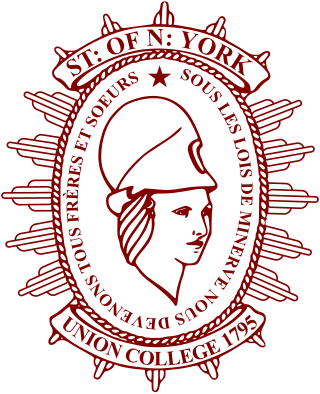
Union College is a private liberal arts college in Schenectady, New York, United States. Founded in 1795, it was the first institution of higher learning chartered by the New York State Board of Regents, and second in the state of New York, after Columbia College. In the 19th century, it became known as the "Mother of Fraternities", as three of the earliest Greek letter societies were established there. Union began enrolling women in 1970, after 175 years as an all-male institution. The college offers a liberal arts curriculum across 21 academic departments, as well as opportunities for interdepartmental majors and self-designed organizing theme majors. The school offers ABET-accredited undergraduate degrees in computer engineering, bioengineering, electrical engineering, and mechanical engineering. About 60% of Union students engage in some form of international study or study abroad.

Joseph Christopher Yates was an American lawyer, politician, statesman, and founding trustee of Union College. He served as seventh governor of New York, from January 1, 1823 – December 31, 1824.
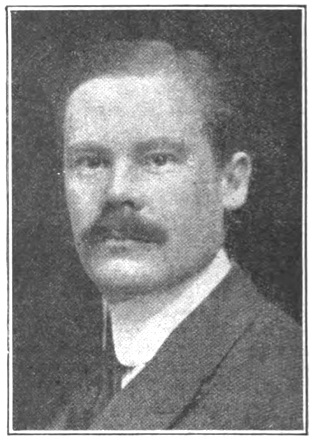
Ernst Frederick Werner Alexanderson was a Swedish-American electrical engineer, who was a pioneer in radio and television development. He invented the Alexanderson alternator, an early radio transmitter used between 1906 and the 1930s for longwave long distance radio transmission. Alexanderson also created the amplidyne, a direct current amplifier used during the Second World War for controlling anti-aircraft guns.
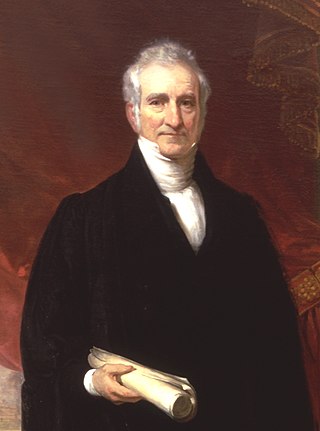
Eliphalet Nott, was a famed Presbyterian minister, inventor, educational pioneer, and long-term president of Union College, Schenectady, New York.

Oakland Cemetery is one of the largest cemetery green spaces in Atlanta, Georgia, U.S. Founded as Atlanta Cemetery in 1850 on six acres (2.4 hectares) of land southeast of the city, it was renamed in 1872 to reflect the large number of oak and magnolia trees growing in the area. By that time, the city had grown and the cemetery had enlarged correspondingly to the current 48 acres (190,000 m2). Since then, Atlanta has continued to expand so that the cemetery is now located in the center of the city. Oakland is an excellent example of a Victorian-style cemetery, and reflects the "garden cemetery" movement started and exemplified by Mount Auburn Cemetery in Massachusetts.
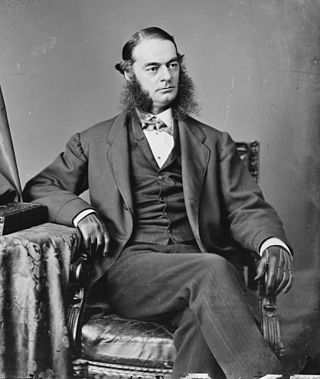
Clarkson Nott Potter was a New York attorney and politician who served four terms in the United States House of Representatives from 1869 to 1875, then again from 1877 to 1879.

Robert Brown Potter was a United States lawyer and a Union Army general in the American Civil War.

The Albany Rural Cemetery was established October 7, 1844, in Menands, New York, United States, just outside the city of Albany, New York. It is renowned as one of the most beautiful, pastoral cemeteries in the U.S., at over 400 acres (1.6 km2). Many historical American figures are buried there.
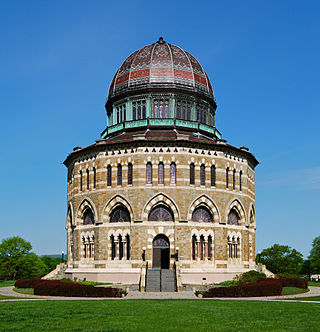
The Nott Memorial is an elaborate 16-sided stone-masonry building which serves as both architectural and physical centerpiece of Union College in Schenectady, New York. Dedicated to Eliphalet Nott, president of Union for a remarkable sixty-two years (1804–1866), the 110-foot (34 m) high by 89-foot (27 m) wide structure is a National Historic Landmark, noted for its distinctive and colorful Victorian architecture.
Edward Tuckerman Potter was an American architect best known for designing the 1871 Mark Twain House in Hartford, Connecticut. With his half-brother William Appleton Potter, he also designed Nott Memorial Hall (1858–79) at his alma mater, Union College, Schenectady, New York. Both the Mark Twain House and Nott Memorial Hall are National Historic Landmarks.

Magnolia Cemetery is a historic city cemetery located in Mobile, Alabama. Filled with many elaborate Victorian-era monuments, it spans more than 100 acres (40 ha). It served as Mobile's primary, and almost exclusive, burial place during the 19th century. It is the final resting place for many of Mobile's 19th- and early 20th-century citizens. The cemetery is roughly bounded by Frye Street to the north, Gayle Street to the east, and Ann Street to the west. Virginia Street originally formed the southern border before the cemetery was expanded and now cuts east–west through the center of the cemetery. Magnolia contains more than 80,000 burials and remains an active, though very limited, burial site today.

Oakwood Cemetery is a nonsectarian rural cemetery in northeastern Troy, New York, United States. It operates under the direction of the Troy Cemetery Association, a non-profit board of directors that deals strictly with the operation of the cemetery. It was established in 1848 in response to the growing rural cemetery movement in New England and went into service in 1850. The cemetery was designed by architect John C. Sidney and underwent its greatest development in the late 19th century under superintendent John Boetcher, who incorporated rare foliage and a clear landscape design strategy. Oakwood was the fourth rural cemetery opened in New York and its governing body was the first rural cemetery association created in the state.

The Stockade Historic District is located in the northwest corner of Schenectady, New York, United States, on the banks of the Mohawk River. It is the oldest neighborhood in the city, continuously inhabited for over 300 years. Union College first held classes in a building within the district, and later it would be one of the termini of an early suspension bridge that was, at the time, the longest in North America. Joseph C. Yates, the 7th Governor of New York and founding trustee of Union College, and Elizabeth V. Gillette, a physician and the first woman from upstate New York elected to the New York State Assembly, were residents of the Stockade.

The General Electric Realty Plot, often referred to locally as the GE Realty Plot, GE Plots or just The Plot, is a residential neighborhood in Schenectady, New York, United States. It is an area of approximately 90 acres (36 ha) just east of Union College.
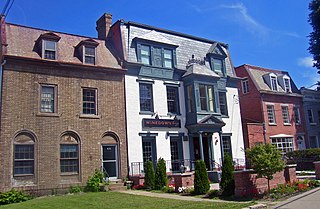
The Union Street Historic District extends along a section of that street in Schenectady, New York, United States. Covering roughly two miles (3.2 km) of both sides of the street, it includes 184 buildings in its 65 acres (26 ha).

Oakdale Memorial Gardens, formerly Oakdale Cemetery, is located in east-central Davenport, Iowa. It contains a section for the burial of pets called the Love of Animals Petland. In 2015, the cemetery was listed as an historic district on the National Register of Historic Places, and as a local landmark on the Davenport Register of Historic Properties. It is also listed on the Network to Freedom, a National Park Service registry for sites associated with the Underground Railroad.

Richard Milford Blatchford was an attorney and political figure in New York City. A longtime political and legal associate of college classmate William H. Seward, Blatchford is most notable for his service in the New York State Assembly and as U.S. Minister to the State of the Church. He was also the father of Samuel Blatchford, who served as an associate justice of the United States Supreme Court.
Moses Viney was born into slavery in Maryland in 1817. During his lifetime he escaped slavery and settled in Schenectady, New York. Viney is best known for his association with Eliphalet Nott for whom Viney was a coachman, messenger and constant companion.


























